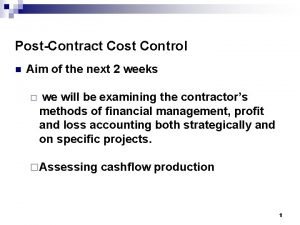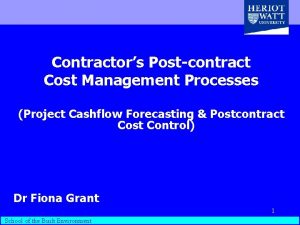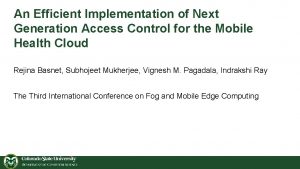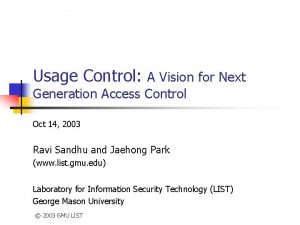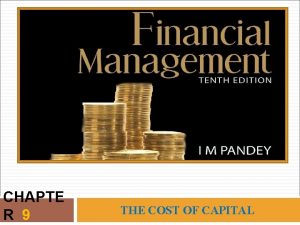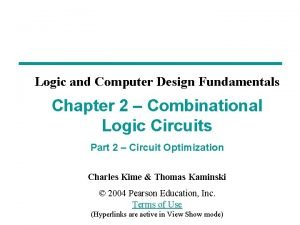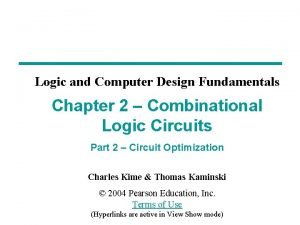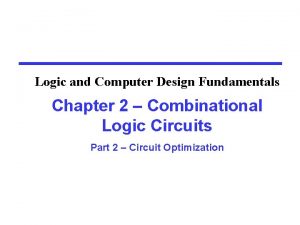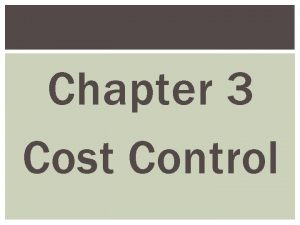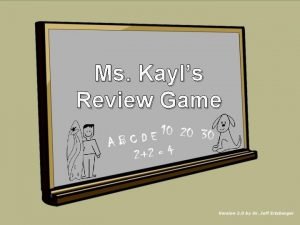PostContract Cost Control n Aim of the next




































- Slides: 36

Post-Contract Cost Control n Aim of the next 2 weeks ¨ we will be examining the contractor’s methods of financial management, profit and loss accounting both strategically and on specific projects. ¨ Assessing cashflow production 1

Post-Contract Cost Control n Some Definitions ¨ ¨ What is a budget? n A budget is an estimate of anticipated company activity and performance for the coming twelve-month period. Once a budget has been established its figures are not changed so that it can be used as a benchmark against which to monitor actual performance; companies will usually review their budgets on a quarterly basis What is a forecast? n A forecast is not dissimilar to a budget, but it is essentially the next step after an annual budget. It is the process by which the budget is updated in the light of current information to hand, and adjusted taking account of that information in forecasts for the remainder of the accounting period. 2

Post-Contract Cost Control n Purpose of producing a budget n The purpose of producing a budget and ongoing forecasts is to be able to estimate the levels of turnover and profit for the coming year. n What is examined? n The performance and duration of current projects n Outstanding final accounts; what is the likely outcome? n The anticipated performance of projects which have been secured but not yet commenced. n Projects which the contractor anticipates may be forthcoming in the next year. Contractors should be aware of the local construction market and have a client base which enables them to plan ahead with some degree of confidence. 3

Post-Contract Cost Control ¨ What is examined? n An analysis of the success rate in converting tenders to secured projects. There may well be tender enquiries and resulting contracts which were not anticipated and which will necessitate a review of the firm’s capacity. n Does the firm wish to expand it’s business, and if so, how will the new business be resourced? n The selection of projects on the basis of anticipated profitability. n An analysis of the projects in the pipeline to ascertain if there is likely to be a shortfall of work in the coming year, and if so what size of projects are needed to fill the gaps 4

Post-Contract Cost Control Consideration of the issues ¨ After considering these issues, the contractor will need to produce an action plan for the coming year; this should provide strategic guidelines on tendering and growth policies for the forthcoming accounting period. 5

Post-Contract Cost Control n The review of current and future projects ¨ In the review of current projects the question has to be asked how does the current performance of a project compare with the original estimate and tender figures? This comparison will be useful in the production of future estimates, tenders and budgets through the provision of feedback. ¨ The review and comparison should look in detail at the profitability of each ongoing project by examining all aspects of the works including: 6

Post-Contract Cost Control n n n Labour and plant; is there sufficient manpower on site to efficiently carry out the works? Materials; are they being purchased from the quoted suppliers? Is any under or over-ordering taking place? Sub contractors; are the ones currently employed taken from the original list at the time of tender? Works in relation to Provisional Sums; how will work expended against these sums enhance the overall profitability of the project? Preliminaries; can savings be achieved? Risk assessment of outstanding works; is all required information being received on time? 7

Post-Contract Cost Control n Objective of budgetary review ¨ is to produce a document scheduling all current activities, and assessing all potential new work forecast to be undertaken in the forthcoming year. ¨ In preparing a budget, it is important to start the process sufficiently close to the new accounting period to achieve optimum accuracy, but early enough to give time for the formulation of an action plan before the start of the new accounting year. 8

Post-Contract Cost Control n Some Definitions ¨ ¨ What is a Profit? n Profit is the net difference between what has been expended in carrying out the business of the company, in this case all costs relating to construction works, and all income generated from such work. Issues such as the yield from shares etc is not considered in this module. What is Preliminaries? n Preliminaries are there to reimburse the contractor for whatever plant and equipment they bring to and maintain on site in order to facilitate the execution of the works. n Thought has to be given as to how such plant and equipment may be considered as overheads as well as items in the Bill against which preliminaries are charged. 9

Post-Contract Cost Control n Overheads and profit ¨ It can be argued that all staff, plant and equipment procured for a specific project are classed as site overheads. However, every other aspect of the business establishment right down to the inclusion of director’s remuneration should be classed as general overheads. Both general and site overheads are the essential costs incurred in the operation of the construction firm. ¨ When, during the time of tender, consideration is given to the way that overheads and profit are to be allocated, the result may be to spread both uniformly throughout the unit rates, or to apportion each against specific items. ¨ Looking at the way in which the construction firm apportions overheads and profits in a broader sense, the firm may attach percentages for both of these uniformly over all projects, or may apportion them against each individual project. 10

Post-Contract Cost Control n A Company’s performance ¨ The budget is fixed and is not adjusted, but it should be reviewed regularly and revised forecasts produced. ¨ During the forecast the original budget is reevaluated; this involves examining each project as in the preparation of the original budget. ¨ Both the original budget and the revised forecasts are used to monitor the company’s performance. 11

Post-Contract Cost Control n Performance of Individual projects ¨ is monitored on a monthly basis by the use of cost / value comparisons or reconciliations. ¨ Data from the cost / value reconciliations is used in producing the revised forecasts of the budget. ¨ The data used for the revisions can be broken down into three main headings which are : n n n Gross Value Cost Profit (loss) ¨ These are sub-divided as follows in figure 10. 1, taken from Walker and Wilkie 1. 12

Post-Contract Cost Control n Some Definitions ¨ What is Cost? n the term ‘cost’ refers to the estimated and total expenditure incurred by the contractor on a specific project, and includes all overheads associated with the project. ¨ What is Value? n The term ‘value’ refers to all costs as above plus the margin of profit. ‘Value’ is the figure paid by the client to the contractor following interim and final certification. ¨ Before the project begins, there will be an analysis from the tender of the project in terms of: n Net cost of production (NCP) n Overheads n Profit. 13

Post-Contract Cost Control n Cost Value Reconciliations ¨ During the course of the project, income and expenditure analysed monthly, and this assessment of cost and value is compared with the initial analysis and anticipated performance. ¨ This comparison is often termed the cost value reconciliation; an equally appropriate term for it would be a profit and loss account. 14

Post-Contract Cost Control Role of the Contractor’s QS ¨ After the contractor’s quantity surveyor has agreed an interim valuation with the consultant quantity surveyor, it is the responsibility of the former to produce an internal assessment of all works completed on site for inclusion in the cost / value reconciliation. ¨ This he or she does in consultation with other departments including the cost and accounts department and the site management team. 15

Post-Contract Cost Control n n Management ¨ At the management meeting any financial problems may be considered and appropriate action taken where necessary to remedy the situation. ¨ Obviously any problems which have arisen should be dealt with as quickly as possible and this is why the reconciliation should be produced as soon as possible after the interim valuation. Estimating Dept ¨ n Information arising from the reconciliation should also be fed back to the estimating department to enable them to take note of any discrepancies or difficulties when preparing future estimates. For accurate comparison to be made, both cost and value should be assessed as at the same date. If the costing date is different from the date of the interim valuation, appropriate adjustments must be made. 16

Post-Contract Cost Control Production of Cost/Value Reconciliation Budget Forecast Sub-contractor liabilities Analysis of measured Bill rates Risk register Cost / Value Reconciliation Materials received (site office) Labour costs Work certified for payment Variations Account Plant returns Overheads (Accounts) Agreed claims 17

Post-Contract Cost Control What is included in CVR? n n The first part of any CVR should include the dates of the interim valuation and CVR. For the CVR to have any relevance it should contain details of contract dates, the original tender and projected final account sums. It should also provide the date up to which the cost has been assessed, allowing for a check against the valuation date. Good practice would suggest that a copy of the architect’s interim valuation certificate should be kept on file in the contractor’s quantity surveyor’s office. This is to verify both the date of the interim valuation and the amount of retention being held; these should relate to the date of the CVR given at the top of the schedule. Where dates of interim valuation certificate and the CVR differ, an explanation should be provided to explain the difference. 18

Post-Contract Cost Control What is included in CVR? n The analysis of value for a CVR can be facilitated by an analysis of all Bill items claimed broken down into their respective headings of labour, sub-contractors, plant, materials, overheads and profit. This analysis can be used as part of the process of building up a figure to represent the gross value of executed work to date. n If the idea of a cost and value comparison as contained in a CVR is taken at its most literal meaning, then it is clear that all details relating to both the costs and value must be assembled in order to obtain a meaningful comparison. 19

Post-Contract Cost Control Gross Value n It is possible that the gross value side of the equation is the most easily assimilated and assembled. n In some ways the build up of the gross value for CVR purposes is not dissimilar from the way in which a client’s financial report is compiled, although there will be obvious differences. 20

Post-Contract Cost Control Below is a list of typical items that might be included in such a report, forming the basis of a contractor’s assessment of the gross value of income for a given project. The contract sum Gross value of work certified to date, detailed in the ‘external’ interim valuation certificate Gross value of work executed to date as detailed in the ‘internal’ assessment Differences between the gross value of work included in the interim valuation certificate and the internal audited gross valuation of executed work; this will require explanation in the report accompanying the CVR. 21

Post-Contract Cost Control Gross Value - list continued n n n PC and Provisional Sums: Variations. Claims. Fluctuations. Retention monies held. Other deductions and Adjustments. 22

Post-Contract Cost Control Analysis of Gross Value n n Any analysis by the contractor of the gross value of executed work, will include a breakdown of the value, between the main contractor’s work detailed in the Bills, and that of nominated and domestic sub-contractors priced in accordance with their quotations. The difference between the two indicates the financial effectiveness of the sub-contractor’s work. . 23

Post-Contract Cost Control Analysis of Gross Value n In producing the CVR, it is important to establish not only the anticipated final account sum and the gross value of work executed to date, but some contractors will also make use of the net gross value, i. e. the value of works completed within the most recent valuation period. n This can be used as a means of calculating the value of fluctuations for the period. It can also be used as a means of examining recent changes in profit or loss making activities. 24

Post-Contract Cost Control Cost n n n The data relating to costs will be assembled from a number of sources, each requiring complete and detailed records. Labour Cost analysis of Bill rates will yield much of the information required in terms of measured work executed on site. If bonuses are paid to operatives, these and all other oncosts should be included; this information may be supplied by the cost and bonus department. Where there has been a need to accelerate the works, allowance in the CVR labour cost analysis should include for non-productive overtime. 25

Post-Contract Cost Control n n Sub-contractors The vast majority of all construction work in the UK is undertaken by sub-contractor labour. When producing a CVR, the contractor’s quantity surveyor should take care to ensure that all known costs in respect of sub-contractors, whether nominated or domestic are included. The most common way of doing this is to produce a detailed schedule of the contractor’s cost liabilities in respect of sub-contractors. To do this, details of the order value is placed against each sub-contractor. The value of work invoiced by and paid to the sub-contractor is included, together with an evaluation of all executed work not yet invoiced, based on the contractor’s quantity surveyor’s appraisal of work completed in their assessment of the gross value discussed above. In the assessment of sub-contract liabilities, attention must be paid to any variations to the sub-contractors work as detailed in the original order, any actual and potential claims paid or outstanding, and in exceptional circumstances, additional payments for acceleration, etc. 26

Post-Contract Cost Control n n n Plant The assessment of these costs will relate to all mechanical and non-mechanical plant. The contractor may hire all plant required for the project in which case it will be a matter of apportioning plant costs throughout the work items on the basis of all known hire charges to date. Plant returns are an obvious source of information. Where plant is owned by the contractor, assessments should be made in respect of the operating costs, repairs and maintenance, depreciation and residual values. 27

Post-Contract Cost Control n n Haulage Allied to plant costs are haulage and transport charges for transporting plant, materials and personnel. Again the charges may be external, or internal if the construction firm own their own haulage fleet. Materials The analysis and CVR should include the invoiced costs of all materials delivered to site. Where materials have been delivered but not invoiced, provision should be made in the costs if this is practicable; costs should also be included of all materials paid for in advance, as well delivery and handling charges. For accuracy, note should also be taken of discounts offered by suppliers and any other charges or refunds to the contractor. Notices of goods received on site are an obvious source of information. 28

Post-Contract Cost Control n n Additional Costs The contractor’s quantity surveyor may also make allowance in the CVR for additional costs due to labour and materials shortages, especially where labour has been brought in from further a field, or where in order to overcome shortages, materials have been imported from overseas. Overheads As with labour, most of these costs can be easily accessed if the tender Bills of Quantities have been analysed by computer or manually to enable abstraction of these figures. Assessment of overheads should take into account all head office as well as site overheads related to the project; residual values are also an aspect for consideration. 29

Post-Contract Cost Control n n Reserves and Contingencies Having completed the general assessment of gross and net values, as well as all costs related to the project, the contractor’s quantity surveyor may be aware that the resulting profit margin appears to be higher than the original figure shown in the tender analysis. In these circumstances, the surveyor may wish to hold some of the ‘surplus’ profit back in the knowledge that less profitable, and even unprofitable activities may lie ahead. To do this the surveyor may create a contingency fund, or perhaps more likely, insert cost reserves against some of the heads of cost within the CVR. To be able to make sound judgements in this respect the quantity surveyor may wish to confer with the site management team to gain an understanding of any potential difficulties which may lie ahead. 30

Post-Contract Cost Control Reconcile differences n n In producing the various assessments required, and compiling the CVR itself, the quantity surveyor must reconcile differences in the value of work certified by the architect, and the value of work actually completed if there are discrepancies between the two. It is usual for the CVR or other related documents to contain explanations relating to these and any other differences. Whilst not having made any allowances for potential claims of inclement weather, others involving loss and expense, or other as yet unsubstantiated situations, the contractor’s quantity surveyor may include comments relating to these and the resulting potential financial consequence. 31

Post-Contract Cost Control Budget Forecast Sub-contractor liabilities Analysis of measured Bill rates Risk register Cost / Value Reconciliation Materials received (site office) Labour costs Work certified for payment Variations Account Plant returns Overheads (Accounts) Agreed claims This figure is a simple example of a cost / value reconciliation designed to show the various sources of data in figure below are combined to form the comparison. 32

Post-Contract Cost Control Problems n n In the above illustration it is clear that there are problems with plant and materials. The combined loss on both of these items is such that the original profit based on the budget is not being met, and unless the situation is rectified, there may be further problems nearer the end of the project when less profitable work and snagging may contribute to an overall loss. In considering what action to take, the quantity surveyor will provide senior management with a report explaining the reasons for the apparent loss on the plant and materials items. 33

Post-Contract Cost Control Skills required by QS n Production of cost / value data, and especially the cost/value reconciliation requires a great deal of skill and personal judgement. n To be able to provide sound accurate reports, the contractor’s quantity surveyor must have an efficient system for filing, collating and recording all data, and for liaising with all departments who assist in providing such data. n There has to be a sound knowledge of the project, the construction programme, construction risks, methods, issues as they arise between the construction and design teams, and a full knowledge of the prevailing contract conditions. On a project of any size, it is likely that the contractor’s quantity surveyor will be based on site, and may well have a staff team to assist in financial and contractual administration of the project. 34

Post-Contract Cost Control To Summarise n n n It is the profitability of a construction project that is likely to determine the contractor’s desire to secure more work at a competitive price. If heavy losses are incurred on a given project, then it is likely that the contractor will seek redress on future work. If the reasons for the loss were to do with issues beyond the contractor’s control, it is probable that this will affect the contractor’s future choice of work; it may even affect their choice of client. When viewing the monitored ongoing and eventual financial outcome of a project, it is essential that the cost and value analyses are looked at honestly and objectively. Feedback must be in sufficient detail to ensure that the correct remedial action is taken so as to ensure that similar losses will not be incurred in future. 35

Tutorial Questions n Produce a flow-chart to illustrate the construction cost control methods used by the contractor from the time of tender enquiry to completion of the project. n Provide brief written notes to be used in conjunction with your flow chart to explain how the processes follow through. 36
 X.next = x.next.next
X.next = x.next.next Post contract cost control
Post contract cost control Postcontract
Postcontract Dennis geyer
Dennis geyer Cost control and cost reduction difference
Cost control and cost reduction difference Cost control and cost reduction project report
Cost control and cost reduction project report Cost control and cost reduction project report
Cost control and cost reduction project report Next generation access control
Next generation access control Next generation access control
Next generation access control Cost accumulation and cost assignment
Cost accumulation and cost assignment Cost accumulation and cost assignment
Cost accumulation and cost assignment Manufacturing cost vs non manufacturing cost
Manufacturing cost vs non manufacturing cost Job costing vs process costing
Job costing vs process costing Floatation cost
Floatation cost Controllable expenses examples
Controllable expenses examples Cost accumulation and cost assignment
Cost accumulation and cost assignment Manufacturing cost vs non manufacturing cost
Manufacturing cost vs non manufacturing cost Standard cost vs budgeted cost
Standard cost vs budgeted cost Book value of debt
Book value of debt What is a period cost on the income statement
What is a period cost on the income statement Standard cost definition
Standard cost definition Literal cost gate input cost
Literal cost gate input cost Distinguish between average cost and marginal cost
Distinguish between average cost and marginal cost The flow of costs in job order costing
The flow of costs in job order costing Ordering cost and carrying cost
Ordering cost and carrying cost Literal cost gate input cost
Literal cost gate input cost Literal cost gate input cost
Literal cost gate input cost Actual cost and opportunity cost
Actual cost and opportunity cost Cost structure refers to the relative proportion of
Cost structure refers to the relative proportion of Hát kết hợp bộ gõ cơ thể
Hát kết hợp bộ gõ cơ thể Ng-html
Ng-html Bổ thể
Bổ thể Tỉ lệ cơ thể trẻ em
Tỉ lệ cơ thể trẻ em Chó sói
Chó sói Chụp phim tư thế worms-breton
Chụp phim tư thế worms-breton Chúa yêu trần thế
Chúa yêu trần thế Môn thể thao bắt đầu bằng chữ đua
Môn thể thao bắt đầu bằng chữ đua

